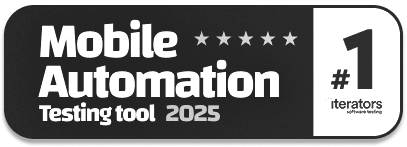Top 10 Generative AI-Based Software Testing Tools
|
|
Generative AI-based testing tools are in vogue these days, and rightly so. These tools attempt to simplify various aspects of software testing, like building test scripts, managing and maintaining them, analyzing test results, and executing test scripts. If you’re looking to up your QA game, then it’s time to upgrade to generative AI-based testing tools.
In this post, we will look at some of the viable options for software testing that use generative AI.
Top 10 Generative AI-Based Software Testing Tools
Here is a quick summary of these software testing tools:
| Sr. No. | Testing Tool | Key Generative AI Features |
|---|---|---|
| 1. | testRigor | Uses generative AI to create test cases, execute, and self-heal them for you in plain English. Test LLMs, graphs, mainframes, and AI features using this AI agent. |
| 2. | Momentic.ai | Smartly uses AI to identify UI elements, make assertions, and handle self-healing of locators in automated test cases. |
| 3. | Blinq.io | Makes use of generative AI to smartly create test automation code from plain language (BDD statements, plain English, and screen recording). |
| 4. | Magnif.ai | Uses AI to generate automated test cases and do visual testing. |
| 5. | Relicx.ai | Offers generative AI-powered agentic workflow, no-code test authoring, and smart locators. |
| 6. | ContextQA | It uses generative AI to analyze requirements and automatically create test cases in natural language and self-healing tests, as well as offer intelligent insights. |
| 7. | Roost.ai | Generative AI-based unit and API test creation. |
| 8. | Qualiti.ai | Makes use of generative AI to simplify test creation in plain English and offers thoughtful analysis for bug triaging. |
| 9. | Esther.ai | It uses generative AI to test and assess various aspects of SaaS platforms, such as functionality, non-functionality, SEO, and accessibility. |
| 10. | EarlyAI | Generative AI-based unit testing platform. |
testRigor
testRigor is an intelligent, generative AI-based test automation tool that simplifies test case creation, execution, and maintenance. It offers a simplistic interface that allows one to write test scripts in simple English without worrying about the application under test’s underlying code and implementation details, such as CSS/XPaths. You can write end-to-end, functional, regression, and even API test cases across multiple platforms and browsers. With easy integration capabilities, you can extend your test automation ecosystem without worrying about vendor lock-ins. The tool uses AI to further bring down test maintenance costs to a bare minimum and make every test run stable and reliable.

Features
- Plain English Test Creation: Allows users to write/generate/record test cases in natural language, which simplifies the test development process. The tool can create a series of test cases for you based on a comprehensive description of the application.
- Test LLMs, Mainframes, and AI Features: testRigor is an AI agent, and therefore, it supports the testing of AI features in your application and LLMs. You can test graphs, images, chatbots, LLMs, Flutter apps, mainframes, and more in simple English language.
- Accessibility and Exploratory Testing: You can efficiently perform accessibility testing through testRigor. Read here how to build an ADA-compliant app. This intelligent tool helps you run exploratory testing with its AI-powered features. Read how to perform exploratory testing with testRigor.
- Cross-Platform Testing: Supports testing for web applications, mobile apps, APIs, and desktop applications, ensuring comprehensive coverage.
- Integration Capabilities: Seamlessly integrates with various CI/CD pipelines, issue-tracking tools, and test management systems. Import or copy/paste manual test cases from TestRail, Zephyr, PractiTest, and so forth, and use them directly as automated tests with minor adjustments in plain English.
- Parallel Test Execution: This feature enables running multiple tests simultaneously across different browsers and devices, reducing overall test execution time.
- Data-Driven Testing: You can create data sets easily within this tool and use them to parametrize your test cases.
- API Testing: Test APIs easily without writing extensive code.
- Reusable Rules: Define repetitive test steps as a reusable rule with a name. Call those test steps by writing their names when required in test cases. Read more: How do you use reusable rules or subroutines in testRigor?
- Supports Testing Enterprise Applications: Easily test ERPs, CRMs, and other enterprise applications in plain English. You can test your Salesforce modules with ease using built-in Salesforce rules.
- Security and Compliance: testRigor is SOC 2 TYPE 2, HIPAA, GDPR, and CCPA compliant. Thus, user data is maintained with the utmost caution and sensitivity.
Pros
- Easy test creation options make automation testing accessible to all. This reduces the overall cost of software testing by using in-house testers and even non-technical team members like product owners.
- Support for a variety of operations like validating email, SMS, and phone calls, 2FA login, uploading files, working with table data, and more.
- Since testRigor does not rely on the underlying code, it can be used to test almost any kind of software, be it a website, desktop application, or mobile app.
- Due to the plain English language commands that this tool uses, you can easily transfer your manual test cases into testRigor. Generative AI further helps automate those statements that do not have a pre-defined meaning in testRigor. In fact, if your test cases use test management tools like TestRail, Zephyr, PractiTest, and so forth, then you can directly link them with testRigor.
Cons
- testRigor does not automate the testing of games. It provides very little support for performance testing.
- Though the tool offers a free version, the test cases created under it are public in nature. For private test cases, you need to select the appropriate plans.
Pricing
- Free Forever: All tests and results are public and available to all.
- Private Linux Chrome: It starts from $300/month. It includes a 14-day trial, which includes one private test suite and parallelization for running tests exclusively on Linux Chrome. It features AI-based test generation and execution.
- Private Complete: It starts from $900/month. It includes a 14-day trial, which includes one private test suite and parallelization for running tests on Ubuntu, Windows, Mac, Android, iOS, and Windows Native, featuring all AI capabilities.
- Custom Enterprise: testRigor supports custom plans for enterprises.
You can view more details about testRigor’s pricing plans over here.
Momentic.ai
Momentic.ai aims to simplify and accelerate various testing processes, particularly for high-velocity engineering teams. It helps developers write and maintain complex end-to-end tests in half the time. You can also automate UI, API, and accessibility testing by using AI to reduce manual effort and improve test reliability.
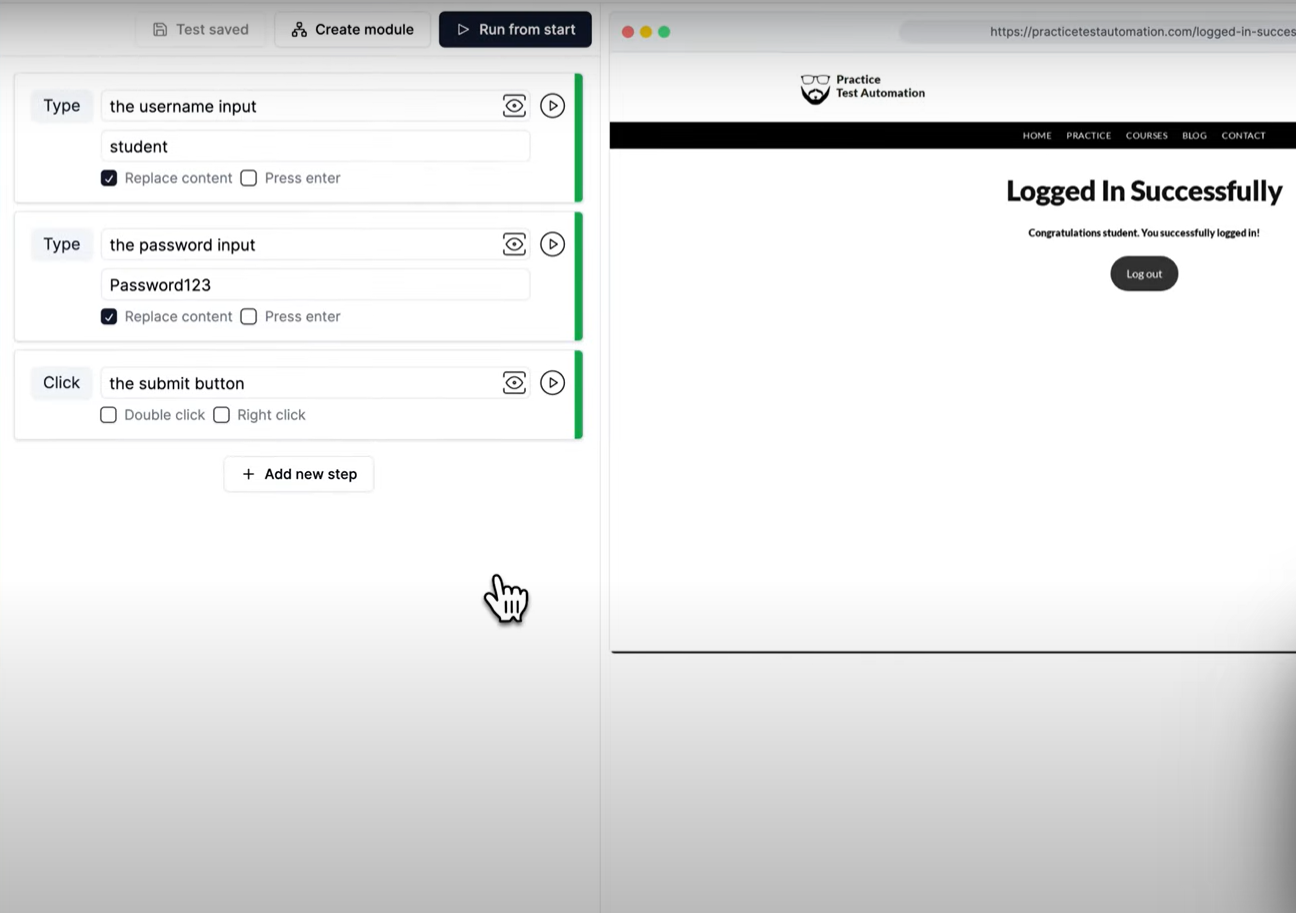
Features
- AI-Powered Element Location (Auto-healing Locators): This is a key AI feature. Instead of relying on brittle XPath or CSS selectors, Momentic’s AI locates elements based on a simple description, visual appearance, and accessibility data. This allows tests to automatically adapt to UI and DOM changes, significantly reducing test maintenance and flakiness. The AI learns and gets smarter with more testing.
- AI-Powered Assertions: Users can craft assertions from any logical statement or visual condition using natural language. This makes it easier to define complex validations without extensive coding.
- AI Action Steps: For sequences of steps, Momentic offers an AI action step that automatically generates sub-steps based on a user-provided goal. If these generated steps break, the AI automatically re-generates them, minimizing human intervention.
- Self-Healing Tests: Momentic’s AI autonomously fixes flaky tests by adapting to application changes. If a UI element moves or changes ID, the AI can still find and interact with it, reducing the need for constant manual updates to test scripts.
- Low-Code Editor: Momentic features an intuitive low-code editor that allows users to create and edit tests easily, even with minimal technical knowledge. It provides real-time updates, console logs, and network logs for live debugging.
- Accessibility Audits: Includes built-in accessibility audits and suggested fixes.
- Flexible Deployment and Execution: Tests can be run using Momentic’s cloud, locally via a CLI, within CI/CD pipelines (integrating with GitHub Actions, CircleCI, GitLab, etc.), or even behind private networks.
- Security and Compliance: Momentic.ai is SOC 2 TYPE 2 certified.
Pros
- Automates a large portion of the testing process, including test creation, maintenance, and execution, leading to faster development and QA cycles.
- The low-code editor and natural language input make it easier for QA professionals, developers, and even non-technical team members to create and manage tests.
- The self-healing and AI-powered element location capabilities drastically cut down on the time and effort required to maintain test suites, especially as applications evolve.
- Integrates well with existing development workflows, CI/CD pipelines, and version control systems.
Cons
- As a relatively newer platform, there might be fewer extensive public reviews or community resources available compared to more established testing tools.
- While user-friendly, new users might need some time to fully grasp and leverage all the AI-based testing concepts and capabilities.
Blinq.io
Blinq.io makes software testing simpler by using generative AI to capture test scenarios in BDD-style test steps. It helps testers automate test cases by recording user actions with a UI. It proves to be quite useful for web apps since it also enables QA teams, product managers, and manual testers to auto-generate functional end-to-end tests without writing extensive code.
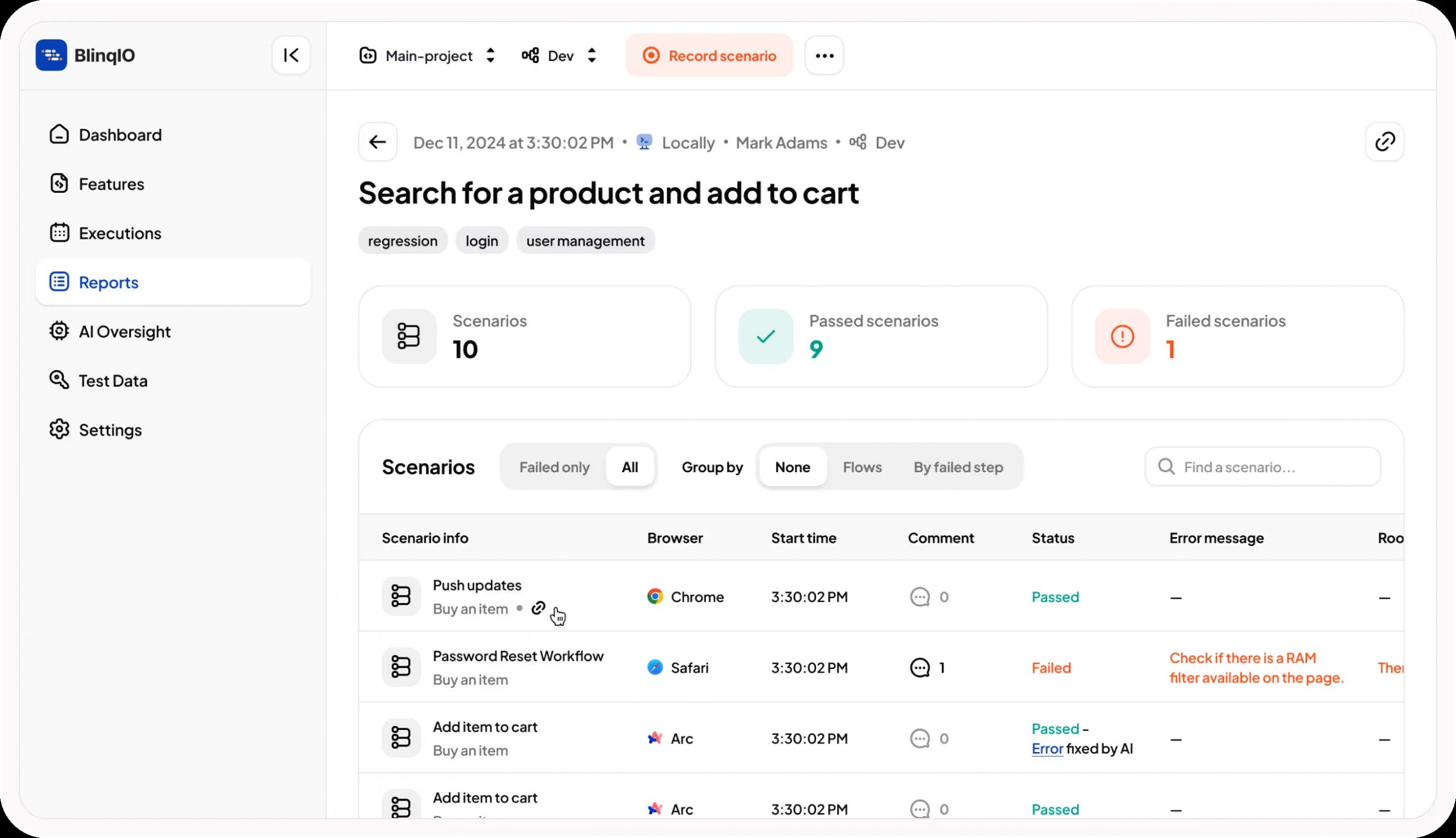
Features
- Autonomous Test Script Generation: This is Blinq.io’s core AI feature. It can generate precise automation code (in open-source Playwright/Appium) from various inputs, including:
- Plain English descriptions: Simply tell it what to test in natural language, and it can create test scenarios based on that description.
- BDD (Behavior-Driven Development) scenarios: You can also input Gherkin syntax to create test cases.
- AI Test Recorder: Users can perform actions on the application, and Blinq.io records them to generate automation code and high-level business descriptions.
- Self-Healing Capabilities: As applications evolve and UI elements change, Blinq.io autonomously adapts and maintains the test code. It detects UI changes and adjusts scripts to ensure they remain relevant, reducing test maintenance effort significantly.
- Multilingual Testing: It supports testing in different languages by generating test automation from a single test description, which is crucial for global applications.
- Test Idea Generation: The AI can suggest new test ideas to improve test coverage.
- Root-Cause Analysis and Defect Classification: Blinq.io can analyze test failures, classify their root causes, and allocate them to relevant functions. It also offers a “human-in-the-loop” audit for AI-suggested code fixes.
- Data Generation and Management: Centralized management of test data, including random data, TOTP (Time-based One-Time Password) two-factor authentication, and random strings.
- Seamless Integrations: Integrates with popular tools like Jira (for task management and bug reporting), TestRail (for test management), CI/CD pipelines, and SSO.
- Reporting: Provides comprehensive test reports.
- Security and Compliance: Blinq.io is SOC 2 TYPE 2 and ISO 27001 compliant. Thus, user data is maintained with the utmost caution and sensitivity.
Pros
- AI Recorder and plain English input make it easier for non-technical users to create and manage tests. This dramatically cuts down the time and expenses associated with manual testing and test automation creation and maintenance.
- Blinq.io’s self-healing capabilities and autonomous maintenance significantly lower the effort needed to update test suites.
- AI can expand the testing matrix to cover more scenarios, platforms, and languages than traditional methods.
- Since it generates open-source Playwright/Appium code, users have full control and flexibility, meaning there’s no vendor lock-in.
Cons
- While Blinq.io offers a great set of features, its price might not work for everyone.
- Blinq.io is primarily optimized for web and mobile applications, not for game testing.
- While positive testimonials exist, there aren’t a vast number of independent user reviews readily available compared to more established testing tools. This can make it harder for new users to gauge widespread user satisfaction.
Magnif.ai
Magnif.ai’s core proposition is to allow teams to convert complex test scenarios into automated tests by generating test cases and automation code directly from project requirements. It offers visual testing to ensure consistency across designs, layouts, and environments, and integrates seamlessly with existing test management tools and frameworks.
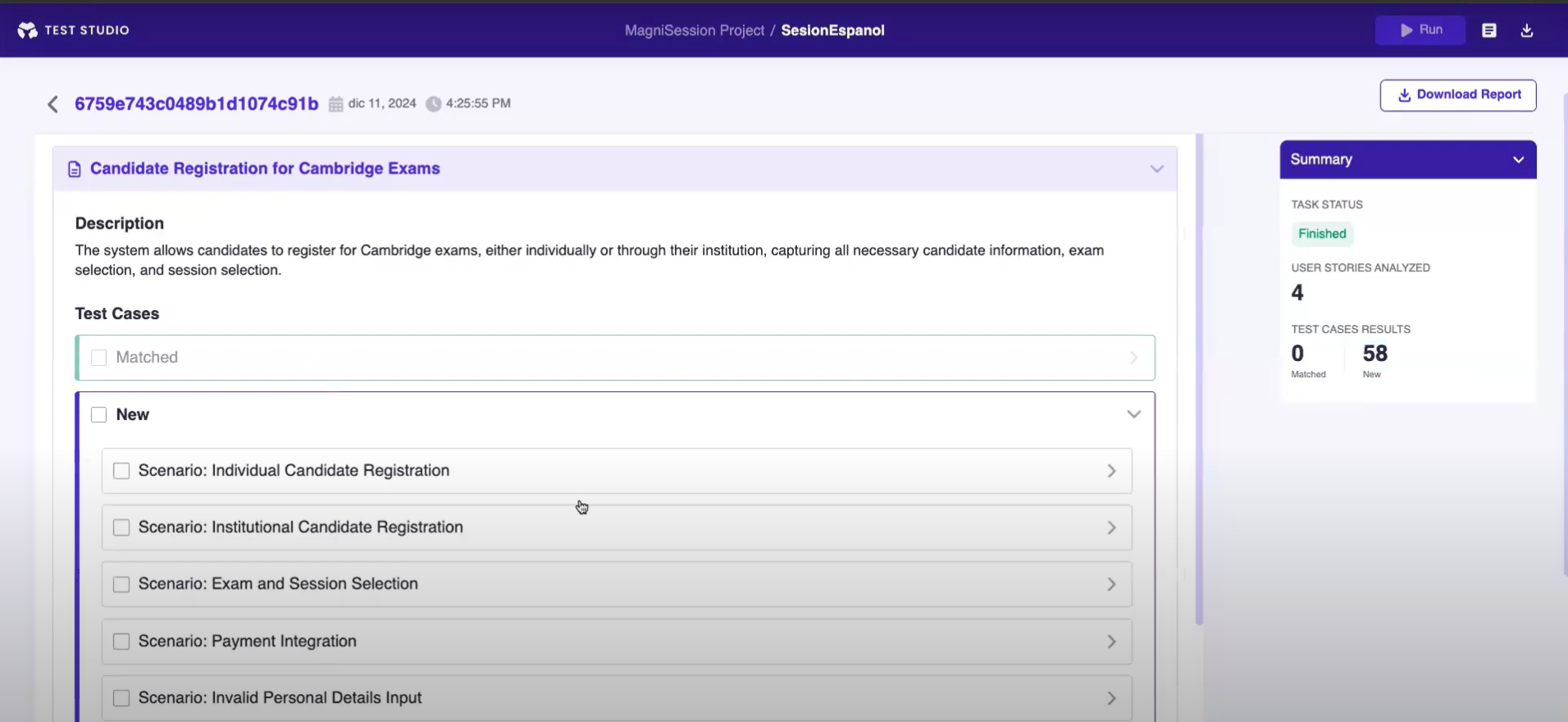
Features
- Generative AI for Test Case & Code Generation: This is a cornerstone feature of this tool. Magnif.ai uses large language models (LLMs) to transform project requirements, user stories, or plain language descriptions into comprehensive test cases.
- Agentic AI for Customized Workflows: The platform uses “agentic AI” to create customized testing workflows and run them instantly. This means the AI can intelligently orchestrate different testing steps and components based on defined goals.
- Computer Vision APIs: It utilizes computer vision to detect subtle visual differences between designs (e.g., Figma) and the final product, ensuring consistency across designs, layouts, and environments.
- MagnifAI Assistant: This is a powerful assistant that can do a lot for you. You can upload files like requirements, code, best practices, and so on to give it context and then ask it questions to optimize or assist with test creation. You can also generate code snippets based on a list of Gherkin test cases. It can even translate your test cases from one programming language to another to make them executable on another framework.
- Test Case Analyzer: Evaluates existing test cases to ensure alignment with requirements and can suggest additional ones to improve coverage.
- Web Bug Hunter: A component within Magnif.ai Test Studio designed to interact with web pages, navigate, take screenshots, and extract information to create reliable, component-based tests for validating broken links, rendering errors, and accessibility issues.
Pros
- Automates repetitive tasks, test case creation, and code generation, drastically reducing manual effort and accelerating the QA process.
- Being a product of Globant, a large and established IT services company, provides credibility, stability, and access to significant R&D resources.
- While it generates code, the focus on natural language input and visual workflow builders suggests it aims to democratize test automation, making it accessible to a broader range of team members beyond highly specialized automation engineers.
- Cloud and on-premise deployment caters to various organizational security and infrastructure requirements.
Cons
- While backed by Globant, Magnif.ai as a specific product, might be newer to the market compared to some long-standing test automation platforms, meaning fewer independent public reviews or community resources are available.
- Even with user-friendly interfaces, effectively leveraging complex AI features like agentic workflows might require a learning curve for teams unfamiliar with such concepts.
Relicx.ai
Relicx.ai is an AI-powered software testing platform that aims to simplify and accelerate the entire software testing process, from test creation to execution and maintenance. It leverages generative AI and machine learning to address common pain points in traditional test automation, such as flaky tests, high maintenance costs, and slow test authoring. A significant development for Relicx.ai is its acquisition of exclusive license rights to its intellectual property by Harness, a modern software delivery platform company. This means Relicx’s capabilities are being integrated directly into the Harness platform, promising enhanced and more comprehensive solutions for software development teams.
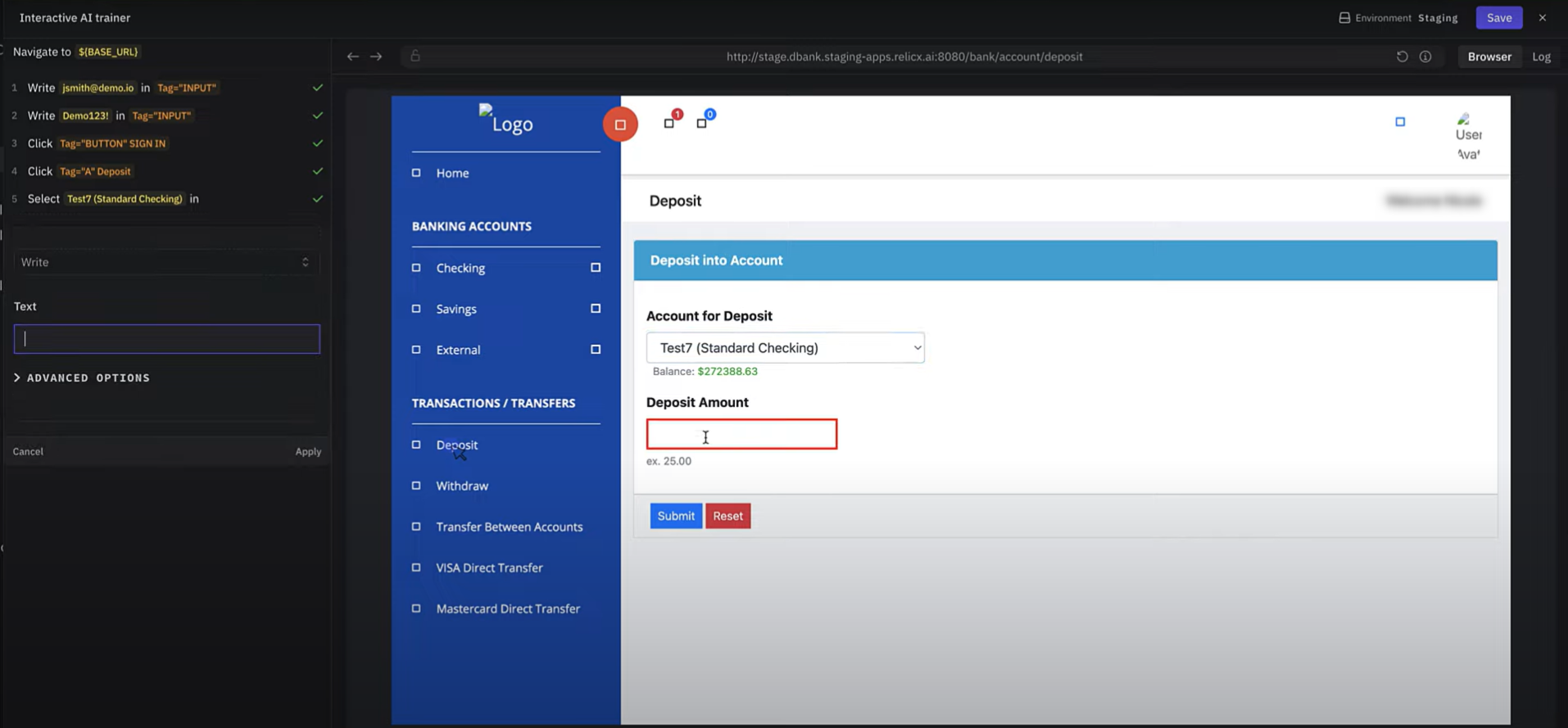
Features
- Generative AI Powered Agentic Workflow (Relicx Copilot): This is a flagship feature, especially in the Enterprise plan. Relicx Copilot allows users to define testing goals in natural language. It then intelligently automates the entire process: analyzing goals, determining necessary actions, interactively executing steps, and validating outcomes. It can also autonomously generate test cases by exploring the application.
- No-Code Test Authoring with Natural Language: Users can create high-quality end-to-end tests quickly without writing code. Tests can be generated by simply interacting with the application in a web browser or by providing natural language prompts (e.g., “Did the login succeed?”).
- Smart Selectors (Self-Healing Tests): Relicx uses advanced AI to analyze hundreds of element attributes to precisely locate UI components. This “smart selector” intelligence enables tests to automatically adapt to UI and DOM changes, even with modern UI frameworks and lazy loading, significantly reducing test maintenance and flakiness.
- AI-Powered Assertions (Auto Assertions): The AI engine automates assertion writing by suggesting relevant assertions after each test step. As users interact with the application and record actions, Relicx intelligently evaluates page states and content, recommending pre-verified assertions for thorough validation.
- Automated Error and Visual Validation: During test execution, Relicx automatically validates various factors impacting user experience, including backend API functionality, frontend errors, dead links, app freezes, and slow pages, flagging issues as “validation failed.”
- Auto Retries: To combat flaky tests caused by environment instability, Relicx automatically retries failed tests a configurable number of times. This helps differentiate between transient issues and genuine application bugs, saving testers debugging time.
- Session Replay and Debugging: Allows users to watch real user sessions to identify and troubleshoot hard-to-reproduce customer bugs and understand the root cause faster.
- CI/CD Pipeline Integration: Seamlessly integrates into CI/CD pipelines via robust API and CLI, allowing for streamlined test executions and automated deployment decisions.
- Security Focused: The tool has SOC2 Type 2 certification and encryption for sensitive data.
Pros
- No-code authoring and natural language input make test automation accessible to a broader range of team members, including QA professionals, product managers, and even non-technical users.
- Significantly reduces test creation time and maintenance effort due to AI-driven self-healing.
- Smart selectors and auto-retries lead to highly stable and reliable tests, cutting down on “false positive” failures.
- The integration with Harness suggests a stable future, continued development, and potentially broader capabilities within the Harness ecosystem.
Cons
- Some of the most advanced Generative AI features (Relicx Copilot) are exclusive to the highest-tier Enterprise plan, which could be a limitation for smaller teams.
- While integration-friendly, setting up seamless CI/CD pipelines might still require some initial technical expertise.
ContextQA
ContextQA positions itself as an all-in-one platform that simplifies testing, enhances efficiency, and improves software quality through a blend of no-code, low-code, and AI-driven capabilities. The core idea is to reduce manual effort, accelerate release cycles, and ensure robust, high-quality software delivery.
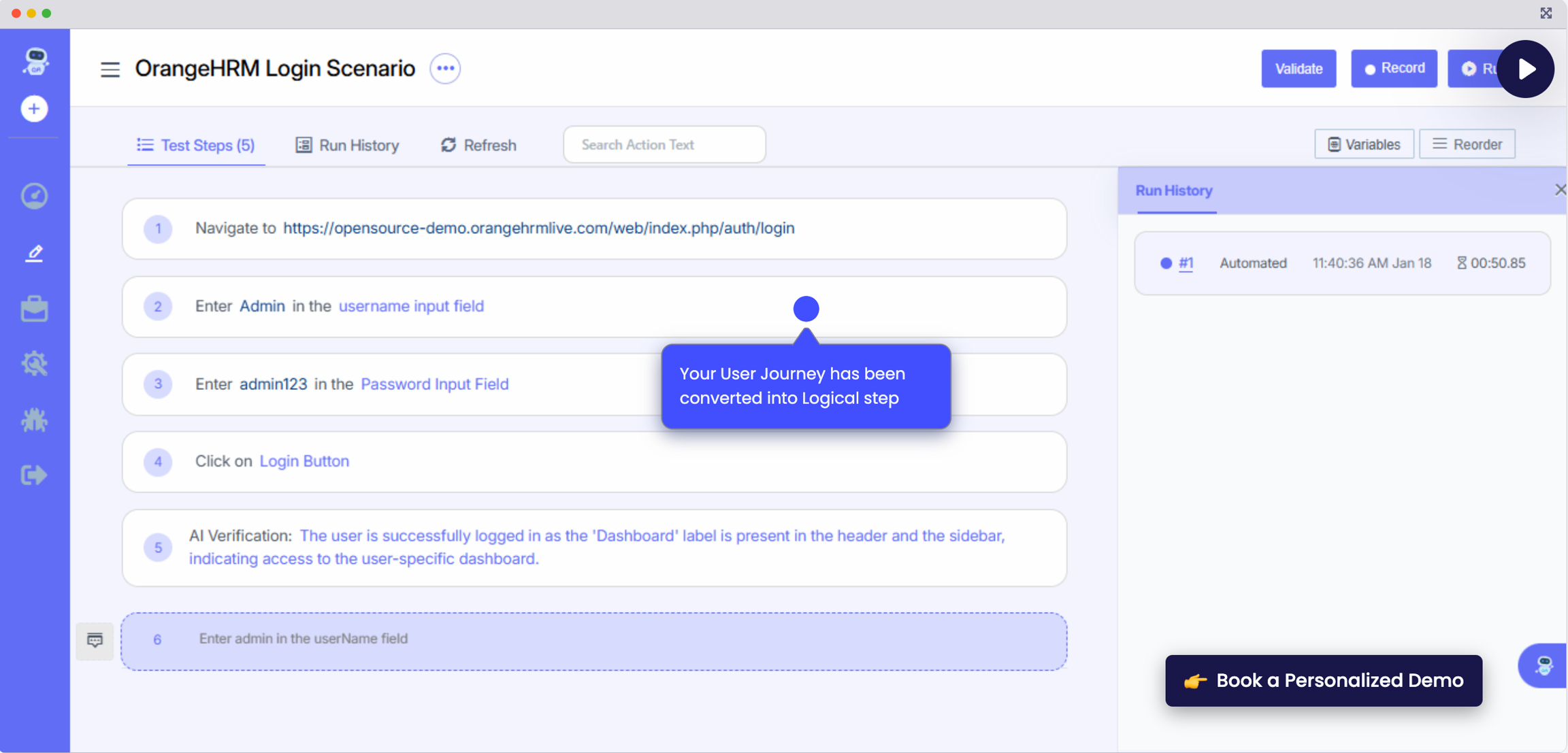
Features
- AI-Driven Web Test Automation: Automates testing processes using AI to create, execute, and maintain tests.
- Easy Test Authoring: You can simply use the AI Agent or Test Recording capabilities to create test cases without writing a line of code.
- AI Test Scenario Generation: Automatically generates comprehensive test cases by analyzing various inputs like feature documentation, user stories, pull requests, and other contextual information using AI. This helps ensure broader test coverage and reduces manual test case creation.
- AI Auto Healing: A critical feature that reduces test maintenance. ContextQA’s AI identifies changes in the application’s UI or underlying structure and automatically updates the tests to align with those changes, preventing tests from breaking due to minor alterations.
- AI-Powered Root Cause Analysis: Utilizes AI to quickly identify and diagnose the root cause of issues, correlating data across multiple sources to pinpoint where a bug originated, significantly accelerating the debugging process.
- AI-Driven Visual Regression Testing: Employs computer vision and AI to detect subtle visual discrepancies and UI bugs between different versions of the application, ensuring a consistent user experience.
- Variety of Testing: You can cover a variety of testing like end-to-end testing, UI testing, accessibility testing, performance testing, and even Salesforce testing.
- Full Code Export: A unique feature allowing users to export their AI-generated test cases to popular open-source frameworks like Selenium and Playwright, providing flexibility and preventing vendor lock-in.
Pros
- AI automation dramatically reduces the time and resources typically spent on test creation, execution, and maintenance.
- The low-code/no-code approach makes test automation accessible to non-technical team members.
- AI helps identify a wider range of defects, including visual and security issues, leading to higher quality software.
Cons
- For extremely specialized or highly custom application behaviors, even AI-generated tests might require further human refinement or custom scripting.
Roost.ai
Roost.ai is an AI-powered software testing platform primarily focused on API testing and unit testing. It aims to address the challenges of manual test scripting, comprehensive test coverage, and the setup/management of test environments by leveraging advanced Generative AI and Large Language Models (LLMs).
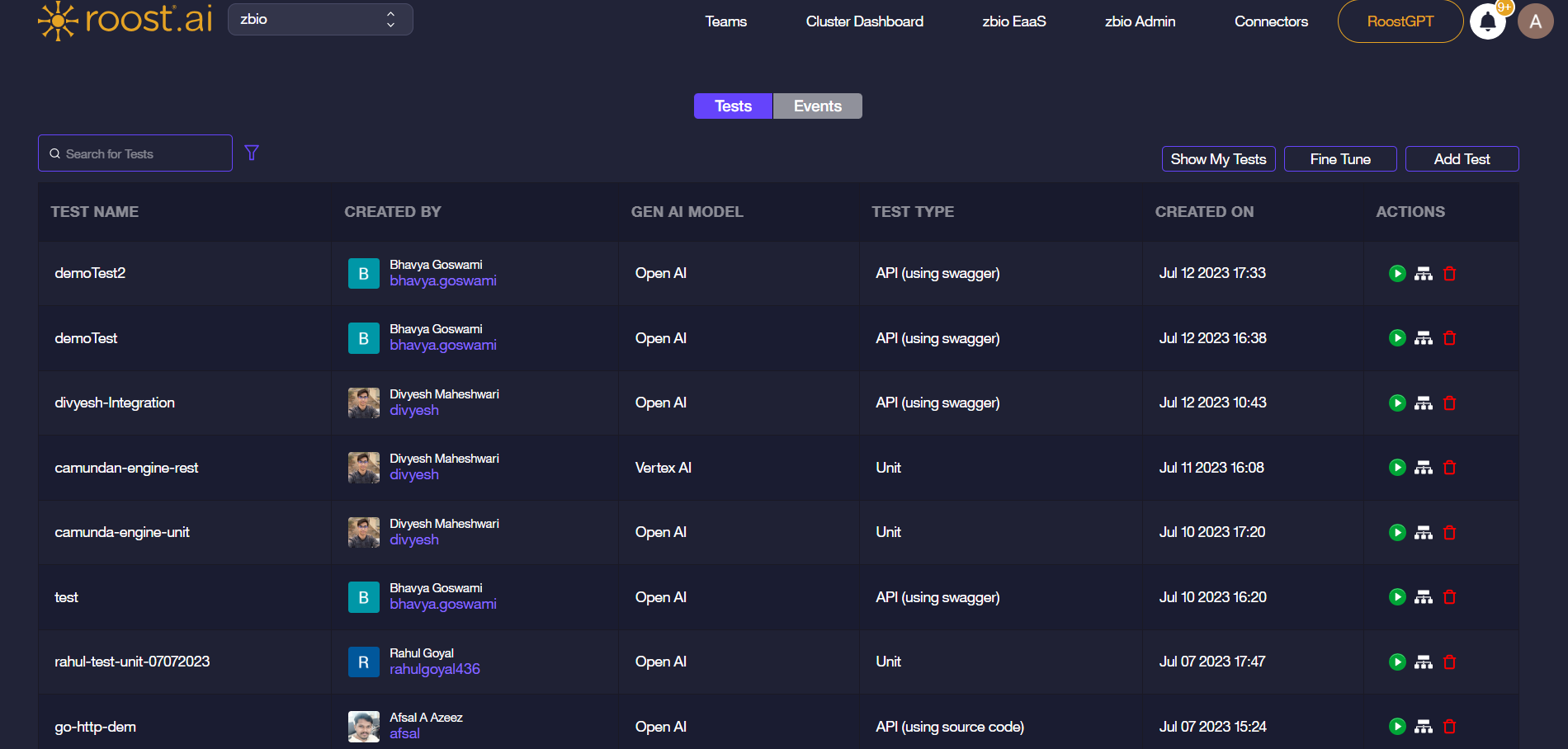
Features
- Generative AI-Powered Test Case Generation (RoostGPT): This is the flagship AI feature. It autonomously crafts intricate and rigorous API and unit test cases. It can generate tests from various inputs:
- Source Code: Analyzes code repositories (GitHub, GitLab, Bitbucket, Azure DevOps).
- User Stories: Integrates with platforms like Jira to understand requirements.
- API Specifications: Processes Swagger, Postman collections, or Open API specifications to discern all API endpoints.
- Application Logs/Traffic: Generates dynamic test data derived from real-world usage patterns, potential errors, and operational data (from sources like Elasticsearch or Amazon CloudWatch).
- Automated Test Updates: RoostGPT automatically adapts to code changes and pull requests, updating the entire unit test library to ensure tests remain relevant and in sync with the evolving codebase.
- Adaptability to Multiple AI Models: While inherently powered by cutting-edge LLMs, RoostGPT provides the flexibility to integrate with models from industry leaders such as OpenAI, Azure OpenAI, or Google Vertex.
- AI-Powered Code Scanning: RoostGPT can scan artifacts like source code and logs to detect static vulnerabilities and ensure no sensitive data is leaking, contributing to security testing.
- Intelligent Test Execution & Coverage: RoostGPT’s advanced algorithms ensure comprehensive coverage of both unit and API test cases, aiming to address every possible scenario and uncover overlooked edge cases that humans might miss.
- AI-enabled auto-discovery of service dependencies: Automates the mapping process for intelligent testing.
- Automatic Commit: RoostGPT can automatically commit the refined test cases to the respective source or test code repositories. This helps ensure that the test suite remains updated and synchronized with the evolving codebase.
Pros
- Automates test case generation for unit and API tests, freeing up developers from manual scripting and significantly accelerating testing cycles.
- Generative AI ensures thorough and exhaustive test coverage, including edge cases often missed by manual or conventional automation.
- AI-driven automated test updates adapt to code changes, minimizing the effort required to maintain test suites.
- It provides flexibility in choosing preferred underlying AI models (OpenAI, Azure OpenAI, Google Vertex).
Cons
- The solutions are priced quite high, which makes it a costly affair.
- While excellent for its focus areas, it might not offer comprehensive UI testing capabilities in the same depth as tools designed purely for end-to-end UI automation (though it addresses visual vulnerabilities in code/logs).
Qualiti.ai
Qualiti.ai is an AI-managed test automation solution designed to streamline and enhance the software quality assurance process, particularly for web applications. It leverages a suite of AI capabilities, including generative AI and machine learning, to automate test creation, execution, and maintenance, aiming to significantly reduce the burden on engineering teams and accelerate release cycles.
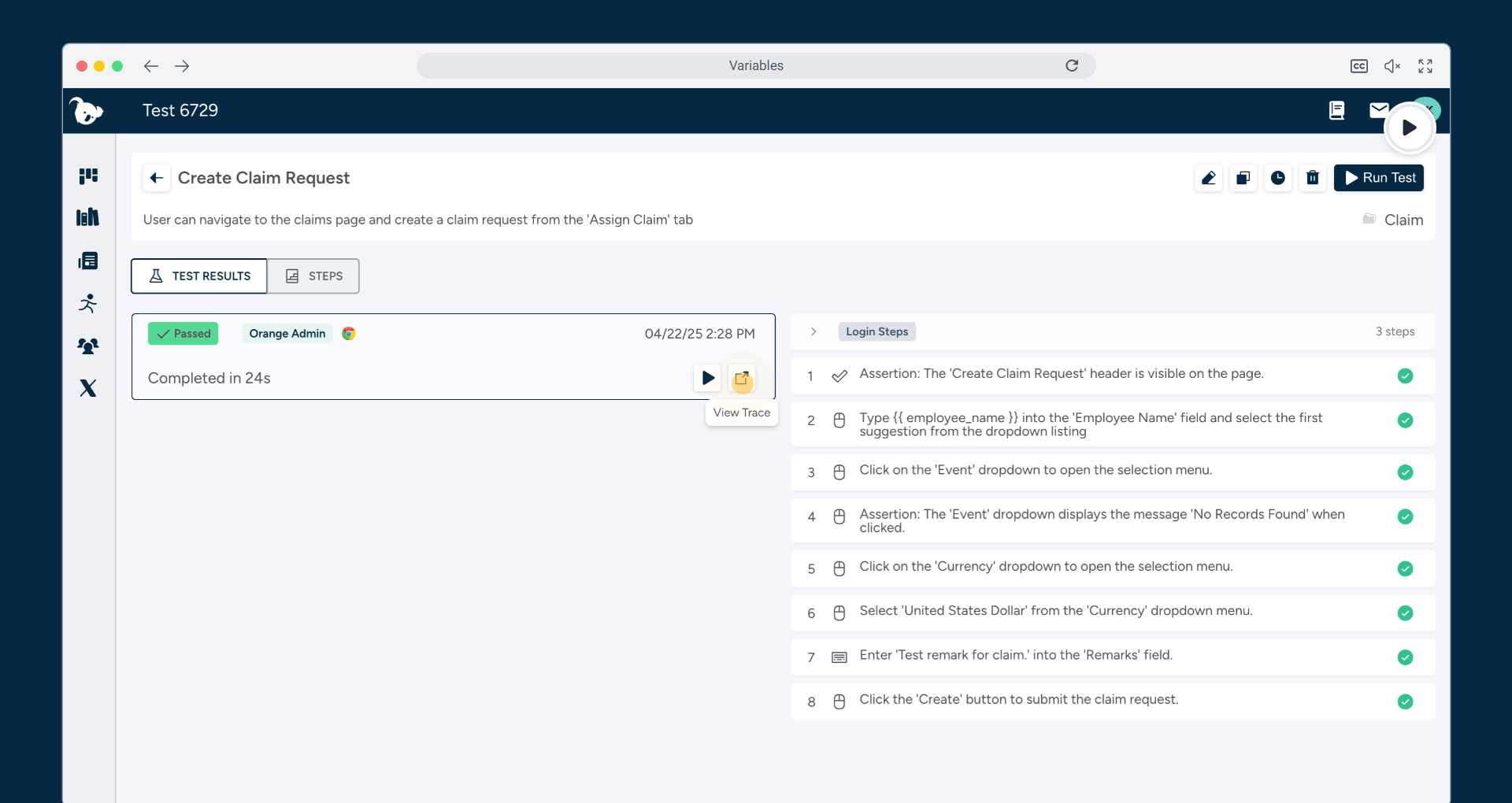
Features
- AI-Driven Test Case Generation: This is a core offering. Qualiti.ai’s AI can generate detailed test cases and steps from various inputs, such as:
- Plain English descriptions: Users can simply describe what they want to test in natural language, like a descriptive prompt to an LLM.
- Application Exploration/Monitoring: The AI can explore your application like a human user, observing user activity and documentation to automatically map features and generate corresponding test cases and user journeys.
- Feature Grouping: Automatically organizes tests into logical feature folders.
- Intelligent Test Execution & Triaging:
- Smart Execution: The AI intelligently runs tests, handling common issues like flaky tests and selector problems.
- AI-Powered Anomaly Detection: Detects and highlights potential defects for immediate attention.
- AI-Triage of Results: The AI helps to triage test results, helping teams focus on actual bugs rather than flaky test failures, and can even generate full bug reports for integration with tools like Jira or Slack.
- AI-Powered Test Coverage Measurement: Provides highly visual dashboards that show exactly what parts of the application are being tested. The AI constantly creates new tests based on user actions, helping to automatically keep test coverage high as the application evolves.
- Context-Driven Testing: Qualiti.ai differentiates itself by understanding context better. By embedding a script that monitors and records user actions within the application under test, it collects valuable data in real time. An AI model ingests this data, identifies patterns in user behavior, and continuously learns from new data sets to refine its understanding. As the model becomes fully trained, it can automatically generate and maintain test cases, ensuring optimal test coverage. Additionally, by providing descriptive prompts during test creation, you can further improve this tool’s ability to create test cases for you.
- Security Focused: The tool has SOC2 Type 2 certification.
Pros
- Automates test creation, which drastically reduces manual efforts.
- AI-driven test generation ensures a broader and more comprehensive test suite, including edge cases.
- Ability to edit tests in English or code and a focus on user approval for AI-suggested changes adds much needed flexibility.
Cons
- While strong in its area, it primarily focuses on frontend web testing and may not cover backend API testing or mobile app testing as comprehensively as some other all-in-one solutions.
- While flexible, the pricing model based on “blocks” of executions might require careful planning to optimize costs for teams with fluctuating testing needs.
Esther.ai
Esther.ai is an AI-driven software testing and debugging SaaS platform. It aims to revolutionize how businesses approach software quality. It leverages generative AI to automate various testing processes, including functional, non-functional, SEO, and accessibility testing. The platform’s goal is to help with testing and debugging SaaS platforms, which assists software development teams in accelerating and reducing the cost of introducing new market features.
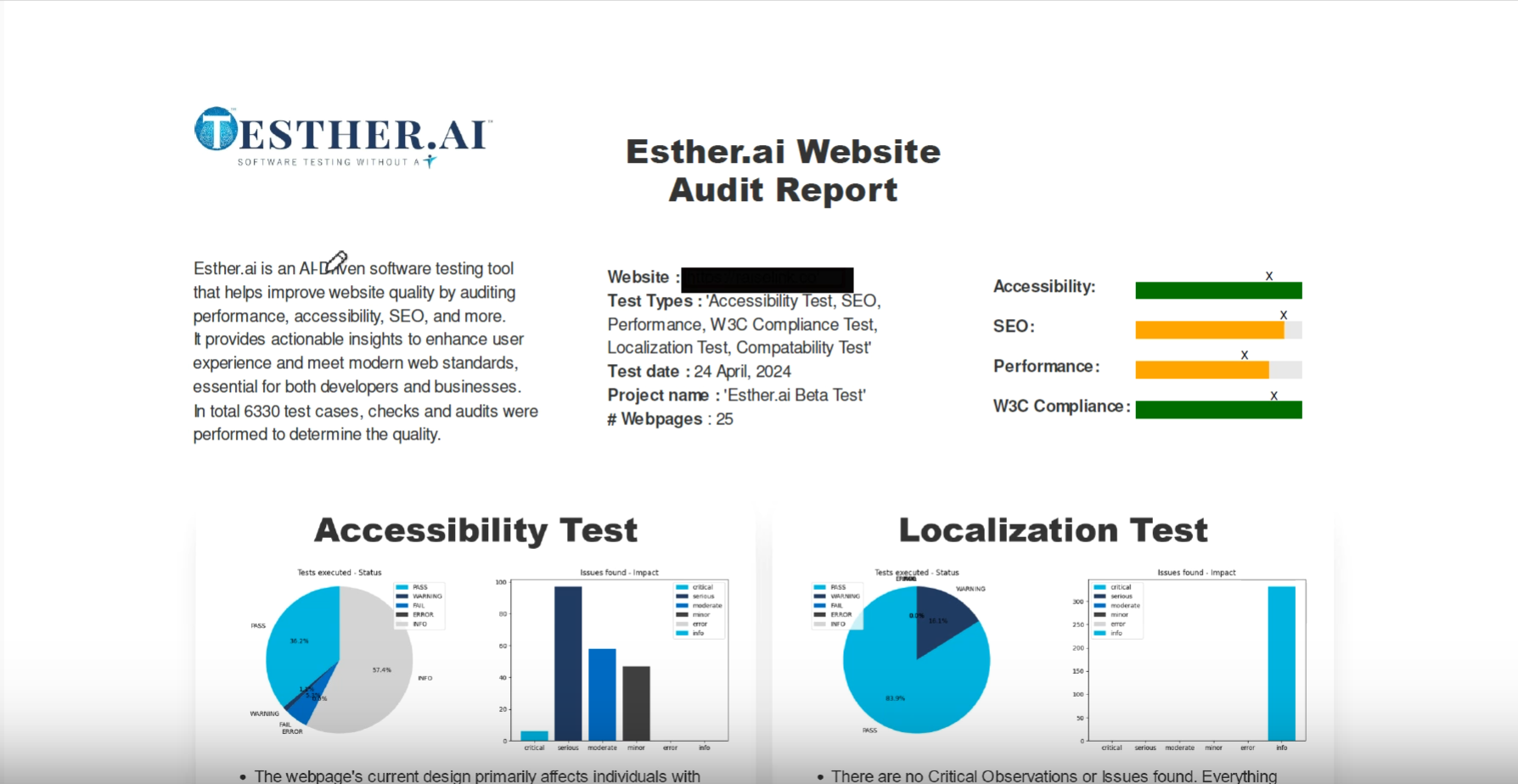
Features
- AI-Driven SEO Audits: Esther.ai performs in-depth SEO analysis across an entire website in seconds, regardless of site size. It can re-test quickly and review performance across all potential search engines and browsers.
- Smart Severity Level Analysis: Prioritizes SEO issues by severity, allowing teams to tackle the most impactful problems first.
- Browser Capability & Search Engine Capture: Reviews SEO performance on all popular browsers (Chrome, Edge, Firefox, etc.) and ensures ranking on all potential search engines (Google, Bing).
- Actionable Accessibility Testing: Uses AI to distinguish potential accessibility issues across an entire website rapidly. It filters these issues by severity and provides examples to help developers and managers diagnose. It also offers immediate solution suggestions to streamline resolution.
- AI-Powered Root Cause Analysis & Debugging: The platform assists in debugging by providing immediate insights, recommendations, and solutions for discovered issues. It can analyze the problem and offer solution suggestions to streamline the resolution process.
Pros
- The AI-powered insights, recommendations, and severity analysis help prioritize and resolve critical issues faster.
- Provides dedicated and robust AI-driven features for critical aspects like SEO and accessibility, which are often overlooked or require specialized tools.
Cons
- Founded in 2023, Esther.ai is newer to the market compared to some established testing platforms.
- While it leverages GenAI, the depth and breadth of its AI capabilities compared to larger, more established AI testing platforms might vary.
EarlyAI
EarlyAI, from Early Technologies Ltd., is an AI-powered development tool primarily focused on automatically generating high-quality unit tests for developers. It aims to streamline the development workflow by integrating directly into Integrated Development Environments (IDEs) like Visual Studio Code to allow developers to focus on writing application code while EarlyAI handles the often tedious and time-consuming task of test creation.

Features
- Generative AI for Automated Unit Test Generation: This is EarlyAI’s flagship feature. It leverages Generative AI to analyze a given codebase and automatically generate comprehensive, working unit tests.
- Function Documentation Generation: Beyond just tests, the AI can also generate clear and concise documentation for functions and methods, improving code readability and maintainability.
- Code Improvement Suggestions: The AI can analyze code and suggest improvements, helping developers write cleaner, more efficient, and potentially more secure code.
- IDE Integration (VS Code): EarlyAI primarily functions as a Visual Studio Code (VS Code) extension, providing a seamless and intuitive experience directly within the developer’s working environment. Users can generate tests with a single click.
- Clear Test Structure: Organizes generated tests following common patterns like Arrange-Act-Assert (AAA), making them easy to understand and review.
- Code Coverage Overview: Provides a visualization or overview of the code coverage achieved by the generated tests, helping developers understand the impact of their testing efforts.
- Scalability: Capable of generating hundreds of working, quality unit tests instantly for projects of various sizes.
Pros
- Automates the creation of unit tests, which is traditionally a very time-consuming task, freeing up developers to focus on feature development.
- Helps achieve high code coverage, ensuring that critical paths and edge cases are adequately tested.
- Integrates seamlessly into the developer’s IDE (VS Code), making it very convenient and part of the existing workflow.
- Lowers the barrier to entry for TDD by automating test creation, making it more approachable for teams.
- Can help quickly generate missing tests for existing or legacy codebases.
Cons
- While expanding, its primary focus is currently on JavaScript and TypeScript. Teams using other languages will need to wait for broader support.
- Primarily a unit testing tool. While crucial, it doesn’t directly address other testing levels like integration, API, or end-to-end UI testing in the same comprehensive manner.
Final Note
This list offers a good starting point for upgrading to generative AI-based testing. Always consider your requirements for the tool before committing to any of them.
Additional Resources
- Top 60 Test Automation Tools to Choose from
- Test Automation Maturity Model
- Paid Automation Testing Tools: Not All Created Equal
- Building Your Own Test Automation Framework: Pros and Cons
- How to Write Effective Test Scripts for Automation?
- When to Use AI in Test Automation: Insights from QA Experts
- Test Automation KPIs
- How to Build a Test Automation Framework
- Choosing Among Popular Test Automation Frameworks: A Guide
| Achieve More Than 90% Test Automation | |
| Step by Step Walkthroughs and Help | |
| 14 Day Free Trial, Cancel Anytime |






